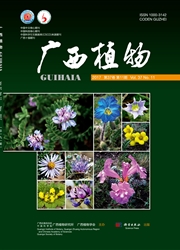

 中文摘要:
中文摘要:
该研究应用常规压片法对7种中国淫羊藿属药用植物进行了核型分析,为淫羊藿属药用植物的分类及选育等提供理论基础。结果表明:7种淫羊藿属植物体细胞染色体数目均为2n=2x=12,基数x=6;水城淫羊藿、腺毛淫羊藿、保靖淫羊藿、拟巫山淫羊藿、天全淫羊藿5个种均有4对m染色体和2对sm染色体,核型公式均为2n=2x=12=8m(2SAT)+4sm,其中水城淫羊藿、腺毛淫羊藿的核型分析为首次报道;镇坪淫羊藿、偏斜淫羊藿具有3对m染色体和3对sm染色体,核型公式为2n=2x=12=6m(2SAT)+6sm。拟巫山淫羊藿第2对染色体具随体,其余物种第1对染色体均有随体;腺毛淫羊藿、保靖淫羊藿、拟巫山淫羊藿、镇坪淫羊藿、偏斜淫羊藿、天全淫羊藿均属于Stebbins 2A类型,水城淫羊藿为Stebbins 1A类型。结合文献综合分析发现,该属植物不同种间的核型高度一致,核型稳定,种间核型差异小,核型结构与地理分布、形态特征相关性较小。因此,淫羊藿属是一个在核型进化上较为保守的植物类群,用核型分析对该属植物属下进行种类鉴定、遗传演化十分困难,即使是属内远缘物种,其核型系统学的意义有限,但在属上的分类级别有较大的参考价值。
 英文摘要:
英文摘要:
In order to provide theoretical basis classification and seed breeding research for the medicinal plants of Epi-medium, we studied seven species of medicinal plants of Chinese Epimedium karyotype, using the conventional pressed discmethod, on the basis of related and summary of phase information consult of karyotype analysis. The results showed that the somatic chromosome numbers were 2n=2x=12, the cardinal numbes were x=6. The E. shuichengense, E. glan-dulosopilosum, E. baojingense, E. wushanense and E. flavum had four pairs of m chromosome and two pairs of sm chro-mosomes, and karyotype for mul as were 2n=2x=12=8m(2SAT)+4sm, among them, analysis on E. shuichengense and E. glandulosopilosum karyotype was reported for the first time;E. ilicifolium, E. Truncatum 2n=2x=12=6m(2SAT)+6sm. The second pair of chromosomes of E. glandulosopilosum were with the middle satellite, and the first pair chromo-some of other species were with the middle satellite. E. glandulosopilosum, E. baojingense, E. wushanense, E. ilicifoli-um, E. Truncatum and E. flavum belonged to“2A” of Stebbins, E. shuichengense belonged to“1A” of Stebbins. The re-sults showed that the differentiation degree of Epimedium karyotype was lower, the correlation between geographical dis-tribution, morphological characteristics and karyotype were smaller, and karyotype structure and geographical distribu-tion, morphological characteristics correlation was smaller. Therefore, Epimedium was a more conservative in karyotype evolution of taxa. It was very difficult to identify the barrenwort subordinate species and genetic evolution using the kary-otype analysis, even within distant species, its karyotype systematics had limited significance, but in the classification level of genera, karyotype analysis still had larger reference value.
 同期刊论文项目
同期刊论文项目
 同项目期刊论文
同项目期刊论文
 期刊信息
期刊信息
